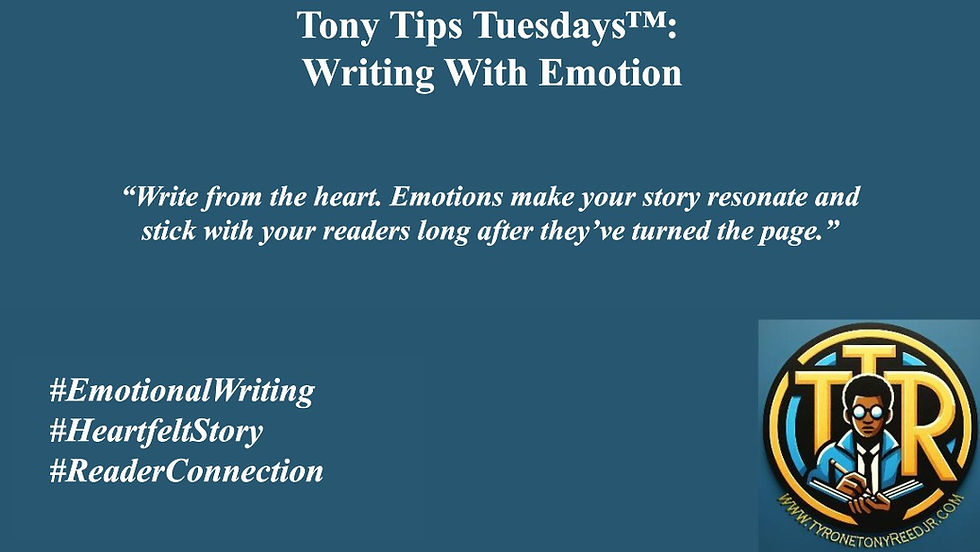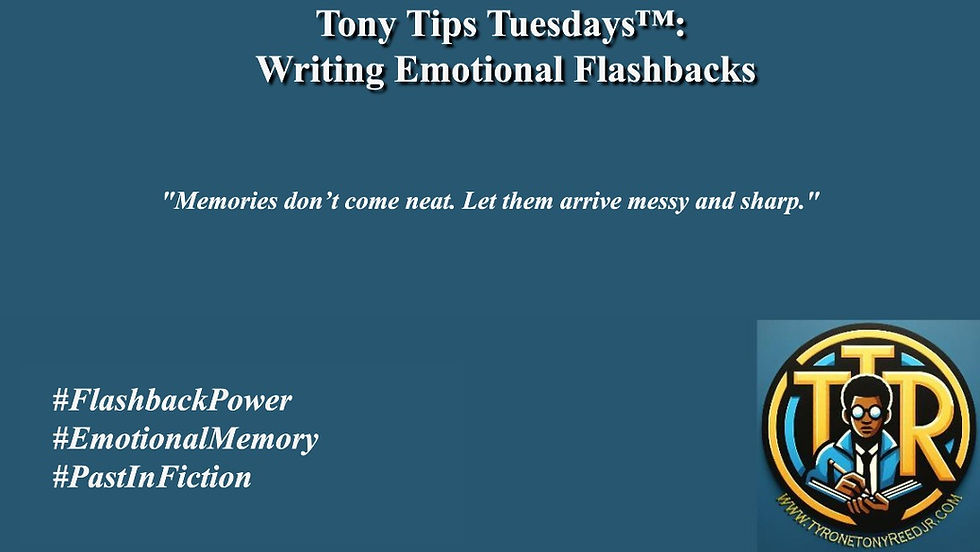Tony Tips Tuesdays™: Writing With Emotion
- Tyrone Tony Reed Jr.

- Aug 12, 2025
- 5 min read

There’s something powerful about a story that makes you cry, cheer, shiver, or smile days after you’ve read the final sentence. It’s not just the plot or the dialogue—it’s the emotion woven through every word. Emotion is the soul of storytelling. It’s what turns a good book into a life-changing experience.
As writers, our job is not just to entertain—it’s to make readers feel. To make them care. And that happens when we stop writing just with our heads and start writing with our hearts.
This week’s Tony Tips Tuesdays™ is all about how to write with emotion that resonates—so your story doesn’t just live on the page, it lives in the hearts of your readers.
1. Understand What Your Character Is Feeling—And Why
To write emotionally rich scenes, you must first feel what your character feels. Not just on the surface, but deep down in their soul.
Ask:
What are they afraid of?
What’s keeping them up at night?
What are they too proud to admit?
What secret longing drives them forward?
When you write from a place of understanding, your words carry weight. You don’t just describe emotion—you transmit it.
📌 Tony Tip: You can’t fake what you haven’t felt. Step into your character’s skin and walk their road.
2. Show Emotion Through Action, Not Just Dialogue
Instead of telling your reader what a character feels, show it through what they do—even (and especially) when their actions contradict their words.
A clenched fist under the table
Eyes darting to the door when they say “I’m fine”
A smile that fades when no one’s watching
A long pause before answering a simple question
These are the details that make emotions come alive.
📌 Tony Tip: Emotion is in the tension between what’s said and what’s shown.
3. Use the Five Senses to Make Emotions Tangible
Emotion isn’t just something you feel inside—it manifests physically. Bring it out by describing how it affects the body and surroundings.
Examples:
Fear tightens the chest, speeds the heart, sharpens sound.
Grief dulls the world, makes time slow, blurs color.
Joy lifts everything, makes light feel golden, music sweeter.
📌 Tony Tip: Use sensory language to make emotion something your readers can see, hear, smell, touch, and taste.
4. Let Your Characters Be Vulnerable
Readers connect most deeply with characters who are raw, real, and vulnerable. Don’t be afraid to show their fears, flaws, or breakdowns.
Let them:
Cry when they need to.
Snap when they feel overwhelmed.
Admit they’re scared.
Ask for help.
Even the strongest hero has weak moments—and those are often the most memorable.
📌 Tony Tip: Vulnerability is not weakness—it’s the bridge between the character and the reader.
5. Don’t Rush the Emotional Moments
The most powerful scenes are often the quietest ones—the lingering silences, the slow realizations, the moments of choice.
Take your time:
Let emotions simmer before they boil over.
Let characters struggle before they break down.
Let the reader feel the weight of what’s happening.
📌 Tony Tip: Let the moment breathe. Stillness can speak louder than action.
6. Write What Hurts—And What Heals
Some of the most beautiful writing comes from our deepest wounds. Tap into your own emotional experiences to bring authenticity to your characters.
Whether it’s:
Losing someone you love
Feeling unseen or unwanted
Struggling with doubt or shame
Experiencing redemption or forgiveness
Use it. Transform it.
📌 Tony Tip: Your pain becomes power on the page when it meets purpose.
7. Use Symbolism to Deepen Emotional Themes
Symbols help carry emotional weight through your story without directly stating it. A broken watch. An old song. A family recipe. A wilting plant. A forgotten voicemail.
These objects or moments can reflect internal emotional states in powerful ways.
📌 Tony Tip: Let your readers feel emotion even when the character doesn’t say a word. Symbols speak volumes.
8. Let Conflict Reveal What Matters Most
Tension and emotional stakes rise when something your character deeply values is under threat—love, trust, dignity, safety, identity.
Create emotional layers by placing your characters in situations where they must:
Choose between what’s right and what’s easy
Fight for someone who doesn’t believe in them
Confront their own beliefs or past mistakes
📌 Tony Tip: What your character is willing to fight—or cry—for shows what they truly value.
9. Vary the Emotional Intensity
Not every scene needs to be a dramatic breakdown or a euphoric high. Mix moments of:
Quiet contentment
Awkward silences
Subtle envy
Nervous laughter
Heartfelt stillness
This emotional rhythm mirrors real life and builds trust with the reader.
📌 Tony Tip: Like music, stories need emotional highs, lows, and quiet spaces in between.
10. End with Emotional Impact
Your final scenes should leave a mark. Whether it’s bittersweet, triumphant, heartbreaking, or hopeful—make sure your story’s emotional resonance lingers.
Don’t tie everything up too neatly. Leave room for reflection. Leave a line that echoes in the reader’s soul.
📌 Tony Tip: Endings aren’t just about resolution—they’re about remembrance.
🔥 5 Emotional Prompts to Stir Your Writing Soul
Write a scene where your character hears a song that reminds them of someone they lost.
Describe a moment when your character realizes they’ve been wrong about someone they love.
Write a goodbye that was never supposed to happen.
Show a character laughing—right before breaking down.
Write a letter your character would never send.
📌 Tony Tip: Prompts don’t just inspire scenes—they unlock the emotions that drive your story.
🛠️ Emotional Tools to Add to Your Writing Toolbox
Journaling as Your Character: Write personal entries in their voice.
Read Poetry: Short, concentrated emotion can teach you a lot.
Watch a Sad or Happy Movie Scene: Analyze how it moved you.
Use Music Playlists: Create emotional soundtracks for your scenes.
Visual Storytelling: Write what a camera would see in an emotional moment.
📌 Tony Tip: Emotion lives in details. Stock your toolbox with tools that help you find the truth beneath the words.
✍🏾 Final Thoughts: The Writer’s Superpower
At the heart of every unforgettable book is a moment that made the reader feel something so real they couldn’t shake it. That’s the magic of writing with emotion.
It’s not about being dramatic. It’s about being honest. It’s about being brave. It’s about opening your own heart so that someone else’s can respond.
So the next time you sit down to write, don’t just focus on clever plots or perfect structure. Focus on what your characters feel. And what you want your readers to feel, too.
📌 Tony Tip: You don’t have to write something loud. You just have to write something true.
📚 Want to Feel Something Powerful? Start Here.
If you want to experience emotionally rich, spiritually powerful storytelling in action, explore my original series S.O.L.A.D.™: Soldiers of Light Against Darkness™.
These stories are rooted in emotion, action, and faith—featuring unforgettable characters who face real pain, make real choices, and experience real transformation.
💥 Grab your autographed copies directly from me at:👉🏾 www.tyronetonyreedjr.com/the-shop
📌 Tony Tip: Writing with emotion changes your story. Reading with emotion can change your life.



Comments